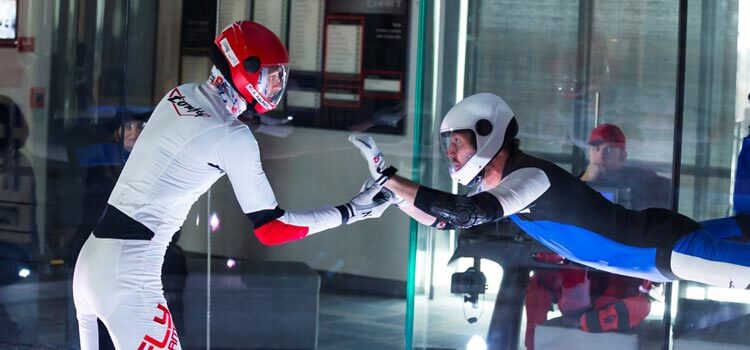Essential Information
Tunnel Coaching 101

[the_ad_placement id=”article-above-content-mobile-only”]
Before we start, please note that this article is aimed at flyers who intend to fly regularly and learn more than just the basics of wind tunnel flight. This includes but is not limited to skydivers looking to take body flight skills from the tunnel to the sky, as well as non-skydivers who want to learn to fly their bodies in the wind tunnel for enjoyment, competition, or both.
Current state of wind tunnel coaching
The number of tunnels that have started popping up all over the world has skyrocketed in the last 5 years. It won’t be long before you can assume that pretty much any large city worldwide will have one (if not two or more) vertical wind tunnel(s).
This creates an amazing opportunity for the sport of indoor skydiving to grow and grow, becoming accessible to a much larger number of people. The number of people learning and teaching body flight will grow at the same rate. This is fantastic, but it makes choosing a coach a much harder task. The goal of this article is to help students inform themselves and make educated decisions when investing in tunnel coaching.
Booking Coaching Through a Coach vs Through a Tunnel
Before we start talking about how to choose a tunnel coach, we need to talk about the difference between booking time through a tunnel coach directly vs booking coaching through a wind tunnel.
How it works:
Essentially tunnel coaching is normally purchased one of two ways.
Students may purchase tunnel coaching directly from a wind tunnel. Generally speaking with this approach you will then be booking time with any eligible tunnel coach at that location. Usually, this is one of the more senior instructors, but not always. This can result in a great experience or a mediocre one – but it is generally out of the consumers’ hands. For repeat customers this also means you may not learn from the same coach twice.
Students may also purchase tunnel coaching by contacting or requesting tunnel coaching directly from a coach. This is generally more difficult for a customer, but will likely lead to a better experience and more productive learning. We always recommended booking a specific coach if you are going to be flying regularly and/or flying a decent amount of time (hours of time).
Now that we know the differences in methods of booking time, we need to talk about tunnel coaches as a whole.
Tunnel Instructors vs Tunnel Coaches
Continuing on the topic of growth in the indoor skydiving industry, we first need to talk about the landscape of coaches that this situation creates. New tunnels require both new and experienced employees.
The job title of an employee working inside a wind tunnel is a “tunnel instructor”. So what does this mean? This means that an employee has the necessary skills to keep a customer who has never been inside a wind tunnel safe.
This is where the difference between tunnel coaches and tunnel instructors comes into play.
Being a tunnel instructor doesn’t automatically make you a tunnel coach.
A tunnel coach is someone who is skilled at teaching and helping a student improve their flying skills while also keeping the student safe.
As a new tunnel instructor gains experience and spends more time instructing, they will need to learn some coaching tools to keep flyers safe.
On this site we refer to a tunnel coach as a person who has the skills to safely teach students a specific set of body flight skills while keeping them safe. It is important to understand that a good number of tunnel coaches are or were at one point tunnel instructors. When we refer to a tunnel instructor. we do not mean the same thing as when we refer to someone as a tunnel coach. In order to make sure the coaches listed in our coach section are indeed qualified teachers, we require credentials, years of experience, and references.
Please also note that as new tunnels pop up all over the world, the number of less experienced tunnel instructors and coaches will grow.
Choosing a Tunnel Coach
Find Your Path
Before you invest in an education in body flight, it is important to consider where you want to end up. Do research on different types of flying. Look at how different coaches fly. Ask yourself what your long term flying goals are. Remember that body flight takes a short time to learn and a long time to master (and it is fun the WHOLE time)
Research Coaches
Once you feel confident in a general direction, start researching coaches who are in that area. Finding a tunnel coach that you wish to fly with. Watch how they fly, watch them coach if you can.
Contact your coach and book time
Contact your coach directly, schedule some time at their local tunnel or during a tunnel camp, and get ready to fly!
Trust your coach
Before you fly remember that you have informed yourself, done your research, and chose the right coach. This is empowering, but doesn’t mean you know what or how the coach should teach you. Trust in your coach and let them mold you into a truly great flyer!
Fly!
Remember to take your time, focus on what you are currently learning, not just the end goal, and most importantly HAVE FUN!!
Published: May 22, 2014 | Last Updated: December 2, 2021
Don’t miss an update!
Join our mailing list for the latest indoor skydiving updates delivered directly to your inbox.
"*" indicates required fields

